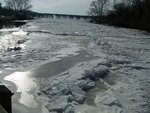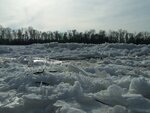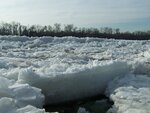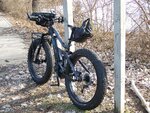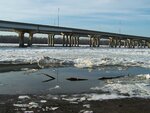Well, so cold and so much snow here the new e-bikes are almost forgotten in the basement.. Sad because we just bought them in October and only had a few weeks to ride them before it got cold and icy. Hats off (or hats on?) to those who brave riding in winter months, it's not for us. I've read articles that say to put the battery on the charger for an hour each month but our batteries seem to be at the same state of charge they were in in November.. IIRC, Lithium Ion cells have very low self discharge rates of 1 or 2% per month so I would think an hour a month in winter would put our batteries way over the 50% state of charge they were left in.
You are using an out of date browser. It may not display this or other websites correctly.
You should upgrade or use an alternative browser.
You should upgrade or use an alternative browser.
Winter doldrums
- Thread starter DDBB
- Start date
ebikemom
Well-Known Member
Yes, and you don't want to over-charge. I think you could put it on the charger a little. Maybe @Ravi Kempaiah can advise? He knows a lot about batteries and battery life.
It must be hard to have those babies in the basement not being used, but SPRING WILL COME!!!! And it will be the BEST Spring EVER!
When I bought our Pedego ebikes in late April last year, the owner's mom said, "you're going to have a blast on these bikes this summer". I had NO idea. We rode them so much more than I ever expected. It was wonderful.
It will be wonderful! I hope you can enjoy some feelings of happy anticipation!
It must be hard to have those babies in the basement not being used, but SPRING WILL COME!!!! And it will be the BEST Spring EVER!
When I bought our Pedego ebikes in late April last year, the owner's mom said, "you're going to have a blast on these bikes this summer". I had NO idea. We rode them so much more than I ever expected. It was wonderful.
It will be wonderful! I hope you can enjoy some feelings of happy anticipation!
D
Deleted member 4210
Guest
You don't want them stored at full charge and no don't charge them intermittently unless the charge state gets below 50%, and even then Less than an hour is fine. Best to have them between 50 and 75% state of charge. Lots of misinformation out there unfortunately on lithium batteries.
Mr. Coffee
Well-Known Member
- Region
- USA
- City
- A Demented Corner of the North Cascades
Winter is time to ski. In the spring there will be bike-skiing. 
elliot friedman
Active Member
Unless there's snow on the ground, I try to ride whenever I can. Good gloves (with liners), down vest, down coat, thermals, etc. We're riding electric bikes so weight barely comes into play. Certainly not as aerodynamic as in the warmer months so speed isn't anticipated. Just to get out there. It's a different experience in the winter. You observe things that you don't in the warmer weather. Unless it's below, say 25 degrees, I try to do some cold weather pedaling even if it's just for a half hour or so to get the juices flowing.
I work in the big apple and couple of days ago it was single digits here. Those delivery guys and couriers were out there doing their thing. More power to them. A little too brisk for my taste.
I work in the big apple and couple of days ago it was single digits here. Those delivery guys and couriers were out there doing their thing. More power to them. A little too brisk for my taste.
Last edited:
christob
Well-Known Member
Luckily the D.C. winters don't usually bring lots of snow; we've had 1 real snowfall so far (about 8 inches). I'm not equipped yet to ride on/through snow, and icy conditions intimidate me enough to skip the day if I know things are icy; but the bike trails I use to commute to work were cleared of all that snow reasonably quickly.
I'll bike to work and back, on dry winter days, so far down to 24 degrees. But I have yet to do any of my usual leisure rides that cold! (December saw 21 biking days and 492 miles accumulated -- in contrast, January (colder, and I had the flu at the start, then our snowfall) saw only 10 biking days and 158 miles.)
I'm probably not equipped for single-digits at this point, though I haven't tried... when Thur morning was 8 degrees at 7am -- I opted to drive to work -- and then saw 3 cyclists biking along my normal commute trail... Bet I could've done it, in hindsight!
I'll bike to work and back, on dry winter days, so far down to 24 degrees. But I have yet to do any of my usual leisure rides that cold! (December saw 21 biking days and 492 miles accumulated -- in contrast, January (colder, and I had the flu at the start, then our snowfall) saw only 10 biking days and 158 miles.)
I'm probably not equipped for single-digits at this point, though I haven't tried... when Thur morning was 8 degrees at 7am -- I opted to drive to work -- and then saw 3 cyclists biking along my normal commute trail... Bet I could've done it, in hindsight!
Mr. Coffee
Well-Known Member
- Region
- USA
- City
- A Demented Corner of the North Cascades
6zfshdb
Well-Known Member
- Region
- USA
- City
- Northeast Pennsylvania
Well, so cold and so much snow here the new e-bikes are almost forgotten in the basement.. Sad because we just bought them in October and only had a few weeks to ride them before it got cold and icy. Hats off (or hats on?) to those who brave riding in winter months, it's not for us.
Although I've been riding conventional bikes for many years, I didn't get in a full season of riding my new e-bike either in 2018. I'm not much of a cold weather rider but I will venture out on a sunny day with no snow on the ground. I break the Winter doldrums by doing bike maintenance and planning bike trips for the coming season. I've taught myself bicycle mechanics and am comfortable doing all my own work. I've found from experience that it pays to be familiar with the equipment on the bike I'm riding.
The e-bike has opened up many prospects for new places to ride. I'm currently planning trips on trails I wouldn't have considered with my old MTB. I have great expectations for the 2019 season!
Bruce Arnold
Well-Known Member
My brother in law who lives in Michigan is telling me about very low temperatures and very high snow. He's an avid cyclist (not ebike) but leaves it in the garage when it gets like this. There are some hardy souls in the Great White North who are out there riding in those conditions, but most of us are better served by looking forward to warmer weather. As with any physical activity, not everyone has the same level of resilience. Proper clothing helps but it's still relative. My hat is off to those who are born with physical abilities I don't have, but as Wilford Brimley remarked in "Crossfire Trail," a man's got to know his limitations.Well, so cold and so much snow here the new e-bikes are almost forgotten in the basement.. Sad because we just bought them in October and only had a few weeks to ride them before it got cold and icy. Hats off (or hats on?) to those who brave riding in winter months, it's not for us. I've read articles that say to put the battery on the charger for an hour each month but our batteries seem to be at the same state of charge they were in in November.. IIRC, Lithium Ion cells have very low self discharge rates of 1 or 2% per month so I would think an hour a month in winter would put our batteries way over the 50% state of charge they were left in.
Tim859
Member
Enjoyed reading this thread. I purchased my first ebike in December of 2018. I've only ridden it about a dozen times but it's been blast. Yesterday was a beautiful weather and my ebike was at the dealer getting the headlight and walk mode enabled. The dealer couldn't understand why I would want to turn off the headlight. Colder than normal temps and feeling sick last month really killed my riding. I'm trying to keep myself busy planning rides and looking forward to commuting again this spring. At least we're getting more daylight now. Not all of my rides are in the dark.
Mike TowpathTraveler
Well-Known Member
Here in NJ, they go overboard on the road salt before, during and after snow fall. So I have to keep an eye on snow melt, as it can do a number on your bike's components if you don't get it off after each ride.
From homebase, it takes me 6 miles of road riding to get to the canal towpath trails. During times of snow fall, I will not put my life in the hands of others slipping and sliding on the roadways next to me as I pedal on the little bit of roadway shoulder that the county has paved in. Instead, I'll await the snow melt and clean roads before I go out.
Dressed warm, in layers of poly-propylene clothing is the trick. Folks miss out on a terrific time of year by not pedaling in the winter. But each person reacts to cold different then the next. For myself anything in the 20's and colder is pushing the limits, especially in the shorter hours of daylight. When it gets that cold and bitter, it pays to have an exit plan to safety, especially if you consider breaking down (ie, flat tire) when you are the furthest point away from your home starting point.
Yesterday we were 2 days removed from the super bitter cold blast from the midwest. I wanted to get out in order to take some pictures of the frozen Delaware River before the last of what I believe to be the ice of winter 2018/19 is gone. Here are some pics of yesterday's ride, and the frozen Delaware at Trenton, NJ....
Regards to battery charging, etc: My Haibike Full FatSix features the Yamaha PW drive system. In a bit over 6000 miles of riding, I simply plug in the charger and let it go until the built in bms system shuts it off when it reaches full charge. Before setting off on a ride, I'll unplug the charger, plug it back in and if the bms senses lower than normal voltage, it will top it off to full. Then, I set off on my ride.
I cannot speak for other ebike charging and battery systems. The Yamaha is really a "set it and forget it" set up. I will assume Bosch is the same way.
From homebase, it takes me 6 miles of road riding to get to the canal towpath trails. During times of snow fall, I will not put my life in the hands of others slipping and sliding on the roadways next to me as I pedal on the little bit of roadway shoulder that the county has paved in. Instead, I'll await the snow melt and clean roads before I go out.
Dressed warm, in layers of poly-propylene clothing is the trick. Folks miss out on a terrific time of year by not pedaling in the winter. But each person reacts to cold different then the next. For myself anything in the 20's and colder is pushing the limits, especially in the shorter hours of daylight. When it gets that cold and bitter, it pays to have an exit plan to safety, especially if you consider breaking down (ie, flat tire) when you are the furthest point away from your home starting point.
Yesterday we were 2 days removed from the super bitter cold blast from the midwest. I wanted to get out in order to take some pictures of the frozen Delaware River before the last of what I believe to be the ice of winter 2018/19 is gone. Here are some pics of yesterday's ride, and the frozen Delaware at Trenton, NJ....
Regards to battery charging, etc: My Haibike Full FatSix features the Yamaha PW drive system. In a bit over 6000 miles of riding, I simply plug in the charger and let it go until the built in bms system shuts it off when it reaches full charge. Before setting off on a ride, I'll unplug the charger, plug it back in and if the bms senses lower than normal voltage, it will top it off to full. Then, I set off on my ride.
I cannot speak for other ebike charging and battery systems. The Yamaha is really a "set it and forget it" set up. I will assume Bosch is the same way.
Attachments
Similar threads
- Replies
- 28
- Views
- 1K
- Replies
- 18
- Views
- 3K
- Replies
- 3
- Views
- 2K
